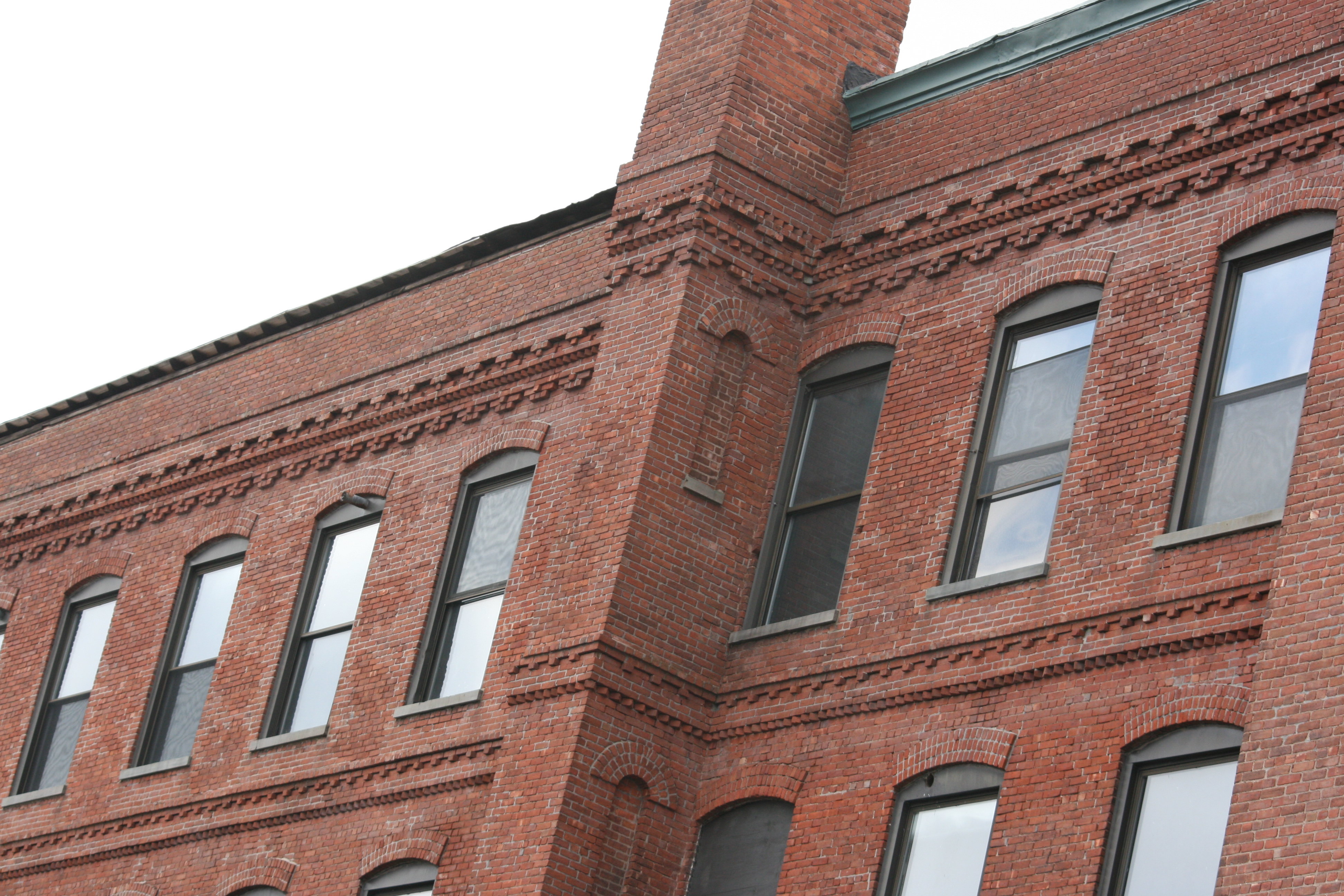Architectural Context, Integrity &
Significance
The Barbour Flax Spinning Grand Street Works was
designed by American architect E.J.M. Derrick and first constructed c.1877 and
enlarged c.1890 as the complex expanded. The 1.5-acre site consists of one
triangular-shaped street block defined by Grand St., to the north, Slater St.
to the south, Prince St. to the east, and Spring St. to the west. The original (1870) 4-1/2 story, colossal
brick mill building is 500 feet long, erected along Spring St., with its front
facing Prince St. to the east. Influenced by the Italianate style, the quadripartite
rectangular design is rich with embellishments, including a brownstone water
table (foundation), horizontal belt courses, a gable end roof facing Grand St.
with an ornamental pediment and complex corbelling. The fifth bay is defined by
a recessed tower with a pyramidal roof cap resembling an Italianate campanile.
A large and handsome corbelled square smokestack further defined the original
site, but is no longer extant. Larger than the 1877 mill, the 1890s expansion
along Grand St. is more simple and understated than its counterpart, but is
unique in its rounded brick angle finishes, terra cotta detailing, larger,
rounded, double-hung window bays. To
complete the U-shaped complex, a smaller two-story addition along Prince St.
was also erected together with the Grand St. addition, leaving a main service
entrance to an interior courtyard off of Prince St. The original works cost
$500K to construct and outfit, and together with additional adjacent land
purchases and expansion, two million dollars was invested in the Grand Street
works by the Barbours. The complex today is in reuse as Treasure Island Mini
Storage, a low-impact reuse that leaves the exteriors intact, including in the
interior courtyard, defined by loading docks, rolling doors and a parking area.
The complex exhibits excellent architectural integrity throughout, and the
architectural merits of this complex alone are sufficiently significant for
designation.
Historic significance, context & association
The site is partly related to Thomas Barbour and the
internationally-renowned Barbour family, one of Paterson's notorious "great
triumvirate industrialists." Their high-quality linen thread, twine and flax
products were internationally recognized and distributed, produced in their Paterson
mills that were recognized as state-of-the-art for nearly a century (1840s-1940s). Indeed, the family trade in thread
manufacturing is traced back as far as 1739 to Scotland, where their first manufactures were established. The
Barbour family continued to expand their business into Ireland and England well
into the nineteenth century, when in the 1864 the decision was made to expand
to Paterson, where they first purchased the Passaic Paper mill #2 on Spruce
Street from the Colt family. The two Barbour
brothers, Thomas and Robert, expanded their business in Paterson over the next
sixty years, including the development of an additional campus on Grand Street
in 1877, and the addition of the Granite Mill in 1881 adjacent to their Spruce
St. complex and the Dolphin Jute Manufacturing Co.
The Barbour family's international
network of mills and machine works brought portability and consistency to their
equipment, manufactured by James D. Barbour in Hilden, Ireland, to their raw
materials (flax purchased from Hilden, northern Ireland, France and Belgium),
and as well as their labor force. Between the Spruce St. and Grand St. mill
complexes developed the still extant "Little Dublin" worker's housing district,
where some of the former brick tenements constructed by the Barbours served as
the first stop for Irish immigrant workers coming to Paterson expressly
recruited by the Barbours to work at their mills. Close to 1,700 workers were
employed in the 1870s alone.
Also of note
is John Edwards Barbour, son of Robert Barbour, in 1909 constructed and lived
at "Kilbarchen," also known as the Barbour Estate, a stately residence
prominently positioned along the highest point of Broadway at the eastern entry
to the city (a municipally-designated historic site).
He operated his own thread and textile
business until his death in 1941. Thomas Barbour's son, Colonel William
Barbour, toured General Grant on his visit to Paterson in 1887, and hosted
President McKinley upon his attendance of Garret Hobart's funeral in Paterson
in 1899. His son was US Senator Warren Barbour, who died in office in 1943,
bringing to a close the Barbour family's dynasty in New Jersey.



References
Archimede,
Gianfranco, Paterson Historic Mills Group Municipal Historic Site Designations
Staff Opinion of Eligibility, 2012.
Department
of City of Paterson Survey Community, 1987
Hyde,
E. B. Atlas of Passaic County, New Jersey, 1877.
Robinson,
E. Atlas of the City of Paterson, New Jersey, 1884.
Robinson,
E. Atlas of the City of Paterson and Haledon, New Jersey, 1899.
Mueller,
A H Atlas of the City of Paterson, New Jersey, 1915.
Sanborn
Map Company Insurance Maps of Paterson, New Jersey, 1915.
Sanborn
Map Company Insurance Maps of the City of Paterson, New Jersey, 1931.
Sanborn
Map Company Insurance Maps of the City of Paterson, New Jersey, 1950.
The
Linen Thread Barbour's Linen Threads and Twines: Selling Agent Company, 1923.
Trumbull,
L. R. A. History of Industrial Paterson, 1882.
Shriner,
Charles A. Paterson, New Jersey, 1890.
The
Paterson Daily and History and Institutions: City of Paterson, N.J. Weekly
Guardian, 1898.
New
York Times, "Death of E.J.M. Derrick," 1880.


